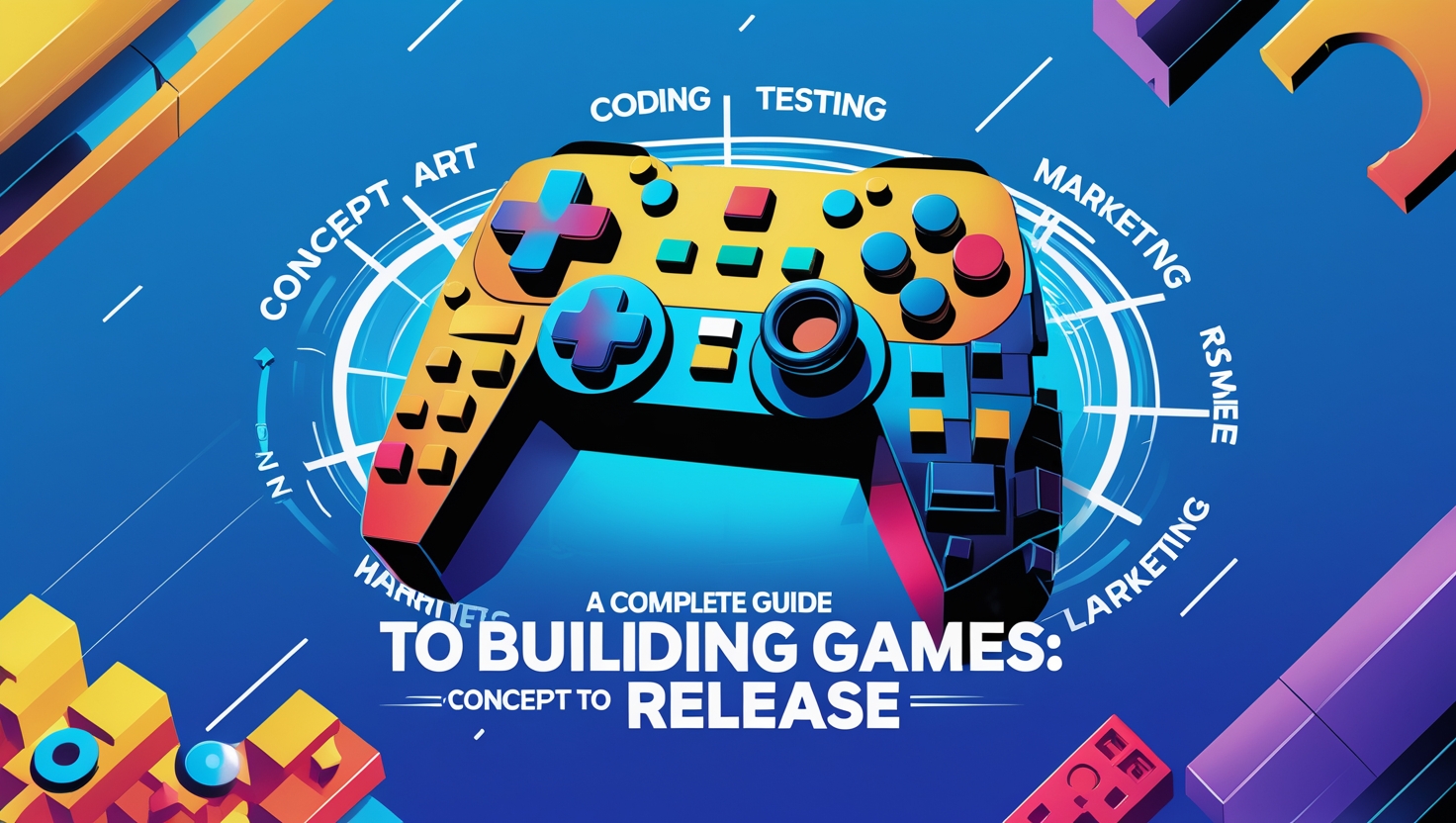Developing a game is no child’s play!
Game developers can vouch that the game development landscape does not look as pretty and exciting as it seems. Months, sometimes years of planning, impending deadlines, trials, and corrections go into creating a video game loved by the targeted audience.
If you are just starting as a game developer, this blog will provide all the steps and processes constituting the game development cycle.
Dive in to explore the madness that goes into creating games that play beautifully.
Game development is a dynamic and exciting process that takes an idea and transforms it into a fully realised, playable product. Whether you’re an indie developer or working with established game development companies, understanding the key stages of this process is essential for creating successful games. Here’s a step-by-step guide, using insights from Unity app development, mobile game design, and industry practices to bring your vision to life.
1. Conceptualization: Defining the Vision
The whole presence of the game revolves around that idea that makes the foundation of a mobile game development process. This idea needs to be unique and engage with the target audience well. A lot of brainstorming and analysis goes into developing the concept that sets it apart from the crowd. A couple of ideas need to be refined before moving on to the further development processes.
- Brainstorm Concepts: Identify the genre, target audience, and unique aspects of your game.
- Create a Game Design Document (GDD): Outline your game’s mechanics, art style, story, and goals.
- Research the Market: Analyze popular entertainment games and best Unity games to understand trends and player expectations.
A well-defined concept ensures clarity and direction as you progress through the development process.
2. Pre-Production: Planning and Prototyping
The development team defines the game concept, creates a vision and mission statement, identifies the target market, specifies the project scope, and creates a timeframe and budget during this first phase of planning. Proper planning is essential to guarantee that everyone in the team knows the game’s goals and can collaborate effectively to produce a quality result.
The idea of the game serves as the backbone of the whole game development process. A sure proof of the concept or idea has to be generated to see how viable and feasible it will be for the gaming studio to develop the game. Proofing an idea must be shared with the publisher of the game, as the publisher will approve a pitch for time, expected budget, and marketing plans.
After the concepts have been proposed, then comes the pre-production step in the picture. In this step, the involved department brainstorms ways to give life to the various ideas laid on the table.
In this stage of the game development process, the writers, artists, marketers, project leads, and several other departments sit together and decide upon the scope of the video game. The writers decide upon the game’s narrative with the assistance of project leads.
The engineers then convey the technological constraints to the writers. Artists and designers work hand-in-hand to make the mobile game visually pleasing. Developers work closely with the engineers to decide the game mechanics.
Pre-production focuses on planning and testing ideas before full-scale development begins.
- Select the Right Tools: For 2D or 3D games, Unity game development is a versatile choice, especially for beginners and professionals alike.
- Build a Prototype: Use Unity to create a basic version of your game that demonstrates its core mechanics.
- Assemble a Team: Collaborate with designers, developers, and artists. If you’re working on a mobile game, ensure your team includes experts in Unity mobile development.
- Outline Milestones: Set timelines and goals for each stage of development.
3. Production: Bringing the Game to Life
The game’s actual development takes place in this stage. This includes making the sound effects and music, planning the levels, implementing the game mechanics, and producing the game’s assets. The team will also conduct routine game testing to find and address any bugs. The production phase of the game development process is usually the longest; therefore, having a committed crew is crucial to the project’s success.
The production phase is where the actual creation of the game takes place.
- Game Design: Develop levels, characters, and environments using tools like Unity’s Scene Editor. Focus on intuitive and engaging mobile game design for mobile platforms.
- Programming: Write scripts to define gameplay mechanics, AI behaviors, and user interactions. Unity’s C# scripting makes this process efficient.
- Art and Animation: Design assets, textures, and animations that align with the game’s theme. For entertainment games, visuals are key to captivating players.
- Sound Design: Add music, sound effects, and voiceovers to enhance immersion.
During production, regular playtesting helps identify and resolve issues early on.
4. Prototyping
Prototyping is not integral to the mobile game development process but has advantages. A prototype helps designers and engineers to experiment and test different aspects of the game, including its mechanics, designs, and functionality. The main point of creating prototypes is to check the feasibility and identify potential issues.
A prototype helps a game development company refine its ideas and ensure that the game’s final version meets the pre-defined standard.
5. Testing: Ensuring Quality
Testing is an important phase of game development because it aids in finding and resolving any faults or problems. In this phase, the development team extensively tests the game to find bugs, glitches, or crashes and works on the feature freeze process. Additionally, the team needs to get testing input and adjust as necessary. These steps ensure the game is playable, stable, and prepared for release.
Quality assurance is vital to ensure your game runs smoothly across devices and platforms.
- Bug Fixing: Test for glitches, crashes, and gameplay inconsistencies.
- Performance Optimization: For mobile platforms, optimize assets and code to ensure seamless performance using tools in Unity mobile development.
- Feedback Collection: Conduct beta testing with a small audience to gather insights and suggestions.
Testing ensures your game delivers a polished experience that players will enjoy.
6. Pre-Launch: Marketing and Distribution
The pre-launch stage of the game development is a stressful time for the developers. They might feel that their game may or may not be loved by the targeted audience.
Pre-launch activities include marketing strategy creation, launch strategy development, distribution channel setup, and beta testing. It creates anticipation and buzz for a compelling game launch. Developers might also exhibit their game at events or employ independent advertising, such as sponsored content or YouTube reviews, to attract targeted audiences and cultivate a fan following.
Preparing for launch involves marketing your game and setting up distribution channels.
- Create a Marketing Plan: Build hype through trailers, social media campaigns, and influencer partnerships.
- Optimize for App Stores: Use ASO (App Store Optimization) techniques to improve visibility on app stores. Highlight features like “Built using Unity app development” to attract tech-savvy players.
- Distribute the Game: Publish your game on platforms like Google Play, Apple App Store, or Steam.
Collaborating with game development companies for marketing and distribution can help you reach a wider audience.
7. Launch: Releasing the Game
The team’s priorities throughout the game’s debut phase are player feedback management, game promotion, and problem-solving, including significant and minor bug fixes. Data on the game’s performance, including player engagement, retention, and monetization, can also be gathered at this stage. The team might keep releasing patches and updates after the launch. The master release signifies the game’s final version and the end of the production process.
The big day has arrived! Focus on:
- Monitoring Performance: Use analytics to track downloads, retention rates, and user feedback.
- Engaging with Players: Respond to reviews and foster a community around your game.
- Updating Regularly: Post-launch updates can fix bugs, introduce new features, and keep players engaged.
Successful launches require ongoing support to maintain momentum and player interest.
8. Post-Launch: Iteration and Growth
The post-release phase of the game provides continuous support and maintenance. This includes keeping an eye on user comments, fixing glitches and problems, delivering patches and updates, and overseeing the community for the game. The post-release phase is essential to keep players interested and ensure the game lasts a long time. This stage may also include creating new features, expansions, and content to keep the game exciting and engaging for players.
The journey doesn’t end with the launch. Post-launch efforts ensure the long-term success of your game.
- Analyze Player Data: Use insights to improve gameplay and address issues.
- Add New Content: Regular updates with new levels, characters, or events keep players returning.
- Plan for the Next Project: Reflect on lessons learned and brainstorm your next game idea.
Trust your gaming vision with Nangkwak Games!
Nangkwak Games stands out in the game development landscape by crafting extraordinary games for Android mobile platforms. With a keen eye for innovation and a commitment to delivering top-notch entertainment, Nangkwak Games consistently produces terrific gaming experiences.
Our Android games seamlessly use amazing graphics, immersive gameplay, engaging narratives, and captivating players from the first tap.
Final Thoughts
From conceptualization to post-launch updates, the game development process is a blend of creativity, technical expertise, and teamwork. Leveraging tools like Unity for app development, mobile development, and game design allows you to bring your ideas to life efficiently. Whether you’re creating casual entertainment games or aiming for the next big hit in best Unity games, following these steps can set you on the path to success.
Game development is as rewarding as it is challenging, but with the right approach, your concept can evolve into a game that players love. Start building today, and who knows? Your game might just be the next big hit!




